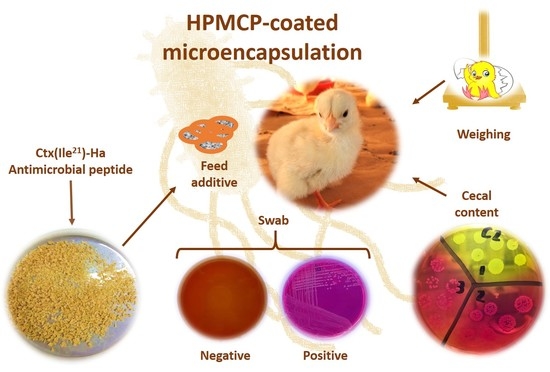HPMCP-Coated Microcapsules Containing the Ctx(Ile21)-Ha Antimicrobial Peptide Reduce the Mortality Rate Caused by Resistant Salmonella Enteritidis in Laying Hens
Abstract
1. Introduction
2. Material and Methods
2.1. Chemical Reagents
2.2. Ctx(Ile21)-Ha Antimicrobial Peptide Synthesis
2.3. Development of Ctx(Ile21)-Ha Coated Microcapsules (ERCtx)
2.4. In Vivo Experiment in Chicks
2.5. Statistical Analysis
3. Results
3.1. Peptide Analysis
3.2. In Vivo Results
3.2.1. Post-Inoculation Treatment Study
3.2.2. Using a Power Test to Analyze Results
3.2.3. Cecal Content
3.2.4. Chick Cloacal Swab
3.2.5. Weighing of the Chicks
4. Discussion
5. Conclusions
6. Patents
Author Contributions
Funding
Institutional Review Board Statement
Informed Consent Statement
Data Availability Statement
Acknowledgments
Conflicts of Interest
References
- Renu, S.; Han, Y.; Dhakal, S.; Lakshmanappa, Y.S.; Ghimire, S.; Feliciano-Ruiz, N.; Senapati, S.; Narasimhan, B.; Selvaraj, R.; Renukaradhya, G.J. Chitosan-adjuvanted Salmonella subunit nanoparticle vaccine for poultry delivered through drinking water and feed. Carbohydr. Polym. 2020, 243, 116434. [Google Scholar] [CrossRef] [PubMed]
- Gaggìa, F.; Mattarelli, P.; Biavati, B. Probiotics and prebiotics in animal feeding for safe food production. Int. J. Food Microbiol. 2010, 141, S15–S28. [Google Scholar] [CrossRef]
- Tacconelli, E.; Carrara, E.; Savoldi, A.; Harbarth, S.; Mendelson, M.; Monnet, D.L.; Pulcini, C.; Kahlmeter, G.; Kluytmans, J.; Carmeli, Y.; et al. Discovery, research, and development of new antibiotics: The WHO priority list of antibiotic-resistant bacteria and tuberculosis. Lancet Infect. Dis. 2018, 18, 318–327. [Google Scholar] [CrossRef]
- World Health Organization. Global Priority List of Antibiotic-Resistant Bacteria to Guide Research, Discovery, and Development of New Antibiotics; World Health Organization: Geneva, Switzerland, 2017. [Google Scholar]
- Ahmed, A.; Siman-Tov, G.; Hall, G.; Bhalla, N.; Narayanan, A. Human Antimicrobial Peptides as Therapeutics for Viral Infections. Viruses 2019, 11, 704. [Google Scholar] [CrossRef] [PubMed]
- Lin, Z.; Wu, T.; Wang, W.; Li, B.; Wang, M.; Chen, L.; Xia, H.; Zhang, T. Biofunctions of antimicrobial peptide-conjugated alginate/hyaluronic acid/collagen wound dressings promote wound healing of a mixed-bacteria-infected wound. Int. J. Biol. Macromol. 2019, 140, 330–342. [Google Scholar] [CrossRef]
- Ferreira Cespedes, G.; Nicolas Lorenzon, E.; Festozo Vicente, E.; Jose Soares Mendes-Giannini, M.; Fontes, W.; de Souza Castro, M.; Maffud Cilli, E. Mechanism of Action and Relationship Between Structure and Biological Activity of Ctx-Ha: A New Ceratotoxin-like Peptide from Hypsiboas albopunctatus. Protein Pept. Lett. 2012, 19, 596–603. [Google Scholar] [CrossRef]
- Vicente, E.F.; Basso, L.G.M.; Cespedes, G.F.; Lorenzón, E.N.; Castro, M.S.; Mendes-Giannini, M.J.S.; Costa-Filho, A.J.; Cilli, E.M. Dynamics and Conformational Studies of TOAC Spin Labeled Analogues of Ctx(Ile21)-Ha Peptide from Hypsiboas albopunctatus. PLoS ONE 2013, 8, e60818. [Google Scholar] [CrossRef]
- Ghibaudo, G.; Santospirito, D.; Sala, A.; Flisi, S.; Taddei, S.; Cavirani, S.; Cabassi, C.S. In vitro antimicrobial activity of a gel containing antimicrobial peptide AMP2041, chlorhexidine digluconate and Tris-EDTA on clinical isolates of Pseudomonas aeruginosa from canine otitis. Vet. Dermatol. 2016, 27, 391. [Google Scholar] [CrossRef]
- Malekkhaiat Häffner, S.; Malmsten, M. Interplay between amphiphilic peptides and nanoparticles for selective membrane destabilization and antimicrobial effects. Curr. Opin. Colloid Interface Sci. 2019, 44, 59–71. [Google Scholar] [CrossRef]
- Roque Borda, C.A.; Saraiva de Mesquita Souza, M.; Monte, F.M.D.; Rodrigues Alves, L.B.; de Almeida, A.M.; Santiago Ferreira, T.; Spina de Lima, T.; Pereira Benevides, V.; Memrava Cabrera, J.; Meneguin, A.B.; et al. Application of HPMCAS-coated Ctx(Ile21)-Ha peptide microparticles as a potential use to prevent systemic infection caused by Salmonella Enteritidis in poultry. bioRxiv 2021. [Google Scholar] [CrossRef]
- Roque Borda, C.A.; Leite Silva, H.R.; Silveira, F.R.; Bustos Mac-Lean, P.A.; Vicente, E.F. Peptídeos antimicrobianos na produção animal: Uma alternativa biosustentável. In Tecnologias Sustentáveis e Agronegócio; Ferrari Putti, F., Casemiro da Silva, A.L., Almeida Gabriel Filho, L.R., Eds.; Editora ANAP: Tupã, São Paulo, Brazil, 2020; pp. 131–166. ISBN 9786586753233. [Google Scholar]
- Silveira, R.F.; Roque Borda, C.A.; Vicente, E.F. Antimicrobial peptides as a feed additive alternative to animal production, food safety and public health implications: An overview. Anim. Nutr. 2021, 7, 603. [Google Scholar]
- Kogut, M.H.; Genovese, K.J.; He, H.; Swaggerty, C.L.; Jiang, Y. Modulation of chicken intestinal immune gene expression by small cationic peptides as feed additives during the first week posthatch. Clin. Vaccine Immunol. 2013, 20, 1440–1448. [Google Scholar] [CrossRef] [PubMed]
- Plazola-Jacinto, C.P.; Pérez-Pérez, V.; Pereyra-Castro, S.C.; Alamilla-Beltrán, L.; Ortiz-Moreno, A. Microencapsulation of biocompounds from avocado leaves oily extracts. Rev. Mex. Ing. Quim. 2019, 18, 1261–1276. [Google Scholar] [CrossRef]
- Harimurti, S.; Ariyadi, B.; Wihandoyo; Akhirini, N.; Pradipta, M.S.I. Growth of probiotics for poultry in glucose yeast pepton media, production of biomass, viability and stability after encapsulation with spray drying. In Proceedings of the IOP Conference Series: Earth and Environmental Science, Graz, Austria, 11–14 September 2019; Institute of Physics Publishing: Bristol, UK, 2019; Volume 387, p. 12130. [Google Scholar]
- Son, Y.R.; Chung, J.H.; Ko, S.; Shim, S.M. Combinational enhancing effects of formulation and encapsulation on digestive stability and intestinal transport of green tea catechins. J. Microencapsul. 2016, 33, 183–190. [Google Scholar] [CrossRef] [PubMed]
- Momoh, M.A.; Akpa, P.A.; Ugwu, K.C.; Kenechukwu, F.C.; Kenneth, O.C. Pharmacodynamics and pharmacokinetics behaviour of insulin from PEGylated-mucin microparticles coated with pH sensitive polymer: Preparation and characterization. Mater. Today Commun. 2020, 25, 101539. [Google Scholar] [CrossRef]
- Roque-Borda, C.A.; Silva, H.R.L.; Crusca Junior, E.; Serafim, J.A.; Meneguin, A.B.; Chorilli, M.; Macedo, W.C.; Teixeira, S.R.; Guastalli, E.A.L.; Soares, N.M.; et al. Alginate-based microparticles coated with HPMCP/AS cellulose-derivatives enable the Ctx(Ile21)-Ha antimicrobial peptide application as a feed additive. Int. J. Biol. Macromol. 2021, 183, 1236–1247. [Google Scholar] [CrossRef] [PubMed]
- Montgomery, D.; Runger, G. Probabilidad y Estadística Aplicadas a la Ingeniería, 2nd ed.; Limusa SA: Mexico City, Mexico, 2012; Volume 817. [Google Scholar]
- Berchieri, A.J.; Murphy, C.K.; Marston, K.; Barrow, P.A. Observations on the persistence and vertical transmission of Salmonella enterica serovars Pullorum and Gallinarum in chickens: Effect of bacterial and host genetic background. Avian Pathol. 2001, 30, 221–231. [Google Scholar] [CrossRef]
- Freitas Neto, O.C.; Arroyave, W.; Alessi, A.C.; Fagliari, J.J.; Berchieri, A. Infection of commercial laying hens with Salmonella gallinarum: Clinical, anatomopathological and haematological studies. Rev. Bras. Cienc. Avic. 2007, 9, 133–141. [Google Scholar] [CrossRef]
- González, R.J.; Sampedro, F.; Feirtag, J.M.; Sánchez-Plata, M.X.; Hedberg, C.W. Prioritization of chicken meat processing interventions on the basis of reducing the Salmonella residual relative risk. J. Food Prot. 2019, 82, 1575–1582. [Google Scholar] [CrossRef]
- Roush, W.B.; Tozer, P.R. The power of tests for bioequivalence in feed experiments with poultry. J. Anim. Sci. 2004, 82, E110–E118. [Google Scholar] [CrossRef]
- Cohen, J. Statistical Power Analysis for the Behavioral Sciences, 2nd ed.; Lawrence Erlbaum Associates Inc.: Hillsdale, MI, USA, 1988; Volume 13. [Google Scholar]
- De Oliveira Barbosa, F.; de Freitas Neto, O.C.; Batista, D.F.A.; de Almeida, A.M.; da Silva Rubio, M.; Alves, L.B.R.; de Oliveira Vasconcelos, R.; Barrow, P.A.; Berchieri Junior, A. Contribution of flagella and motility to gut colonisation and pathogenicity of Salmonella Enteritidis in the chicken. Braz. J. Microbiol. 2017, 48, 754–759. [Google Scholar] [CrossRef] [PubMed]
- He, H.; Lowry, V.K.; Swaggerty, C.L.; Ferro, P.J.; Kogut, M.H. In vitro activation of chicken leukocytes and in vivo protection against Salmonella enteritidis organ invasion and peritoneal S. enteritidis infection-induced mortality in neonatal chickens by immunostimulatory CpG oligodeoxynucleotide. FEMS Immunol. Med. Microbiol. 2005, 43, 81–89. [Google Scholar] [CrossRef]
- Xu, B.; Fu, J.; Zhu, L.; Li, Z.; Jin, M.; Wang, Y. Overall assessment of antibiotic substitutes for pigs: A set of meta-analyses. J. Anim. Sci. Biotechnol. 2021, 12, 3. [Google Scholar] [CrossRef] [PubMed]
- Vincent, P.A.; Delgado, M.A.; Farías, R.N.; Salomón, R.A. Inhibition of Salmonella enterica serovars by microcin J25. FEMS Microbiol. Lett. 2004, 236, 103–107. [Google Scholar] [CrossRef] [PubMed][Green Version]
- Wang, G.; Song, Q.; Huang, S.; Wang, Y.; Cai, S.; Yu, H.; Ding, X.; Zeng, X.; Zhang, J. Effect of Antimicrobial Peptide Microcin J25 on Growth Performance, Immune Regulation, and Intestinal Microbiota in Broiler Chickens Challenged with Escherichia coli and Salmonella. Animals 2020, 10, 345. [Google Scholar] [CrossRef] [PubMed]
- Ben Lagha, A.; Haas, B.; Gottschalk, M.; Grenier, D. Antimicrobial potential of bacteriocins in poultry and swine production. Vet. Res. 2017, 48, 22. [Google Scholar] [CrossRef] [PubMed]
- Wang, H.-T.; Yu, C.; Hsieh, Y.-H.; Chen, S.-W.; Chen, B.-J.; Chen, C.-Y. Effects of albusin B (a bacteriocin) of Ruminococcus albus 7 expressed by yeast on growth performance and intestinal absorption of broiler chickens-its potential role as an alternative to feed antibiotics. J. Sci. Food Agric. 2011, 91, 2338–2343. [Google Scholar] [CrossRef]
- Wang, D.; Ma, W.; She, R.; Sun, Q.; Liu, Y.; Hu, Y.; Liu, L.; Yang, Y.; Peng, K. Effects of swine gut antimicrobial peptides on the intestinal mucosal immunity in specific-pathogen-free chickens. Poult. Sci. 2009, 88, 967–974. [Google Scholar] [CrossRef]
- Liu, T.; She, R.; Wang, K.; Bao, H.; Zhang, Y.; Luo, D.; Hu, Y.; Ding, Y.; Wang, D.; Peng, K. Effects of rabbit sacculus rotundus antimicrobial peptides on the intestinal mucosal immunity in chickens. Poult. Sci. 2008, 87, 250–254. [Google Scholar] [CrossRef]
- Stern, N.J.; Svetoch, E.A.; Eruslanov, B.V.; Kovalev, Y.N.; Volodina, L.I.; Perelygin, V.V.; Mitsevich, E.V.; Mitsevich, I.P.; Levchuk, V.P. Paenibacillus polymyxa purified bacteriocin to control Campylobacter jejuni in chickens. J. Food Prot. 2005, 68, 1450–1453. [Google Scholar] [CrossRef]
- Lee, K.Y.; Mooney, D.J. Alginate: Properties and biomedical applications. Prog. Polym. Sci. 2012, 37, 106–126. [Google Scholar] [CrossRef] [PubMed]
- Soto, M.J.; Retamales, J.; Palza, H.; Bastías, R. Encapsulation of specific Salmonella Enteritidis phage f3αSE on alginate-spheres as a method for protection and dosification. Electron. J. Biotechnol. 2018, 31, 57–60. [Google Scholar] [CrossRef]
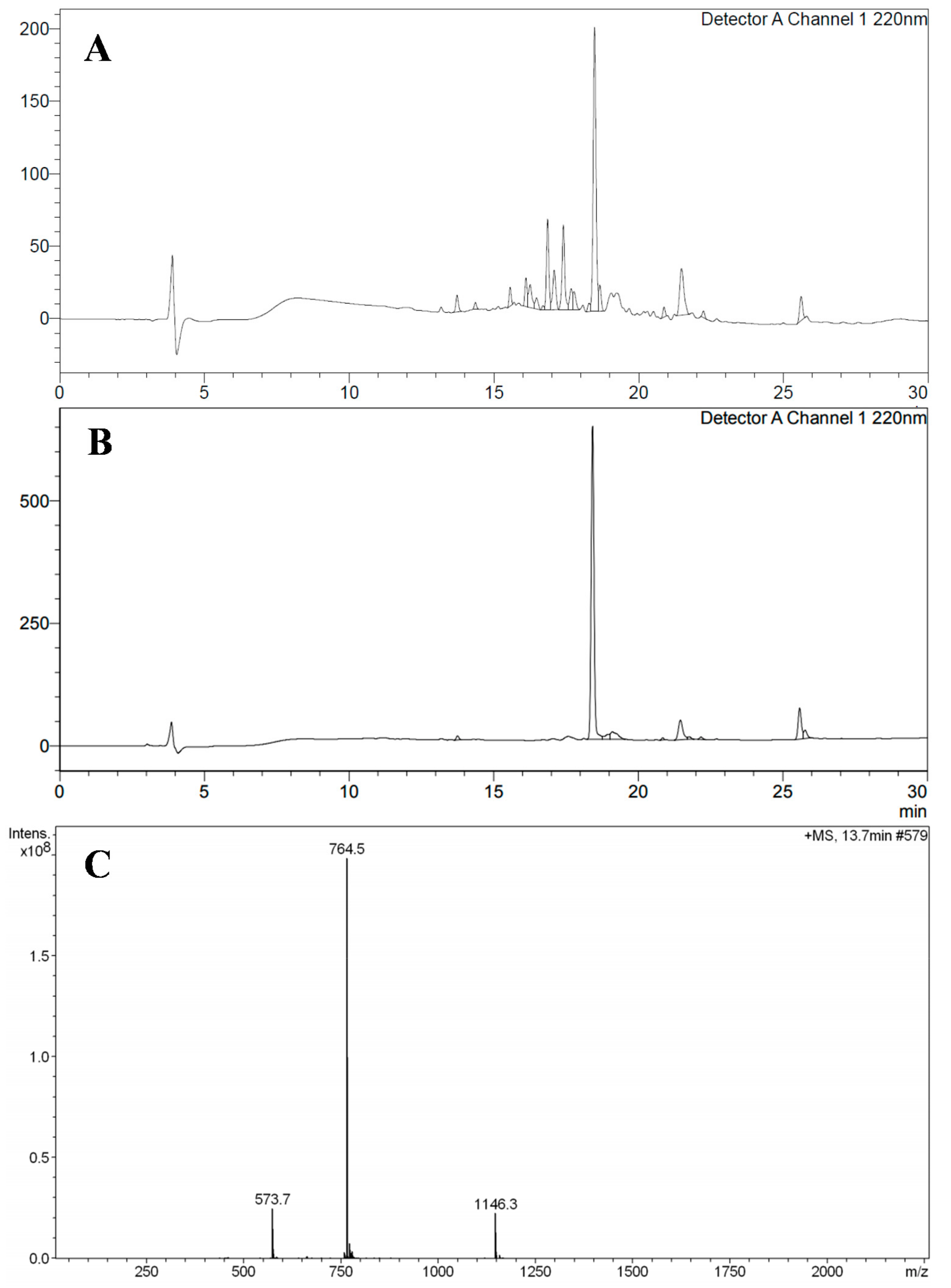
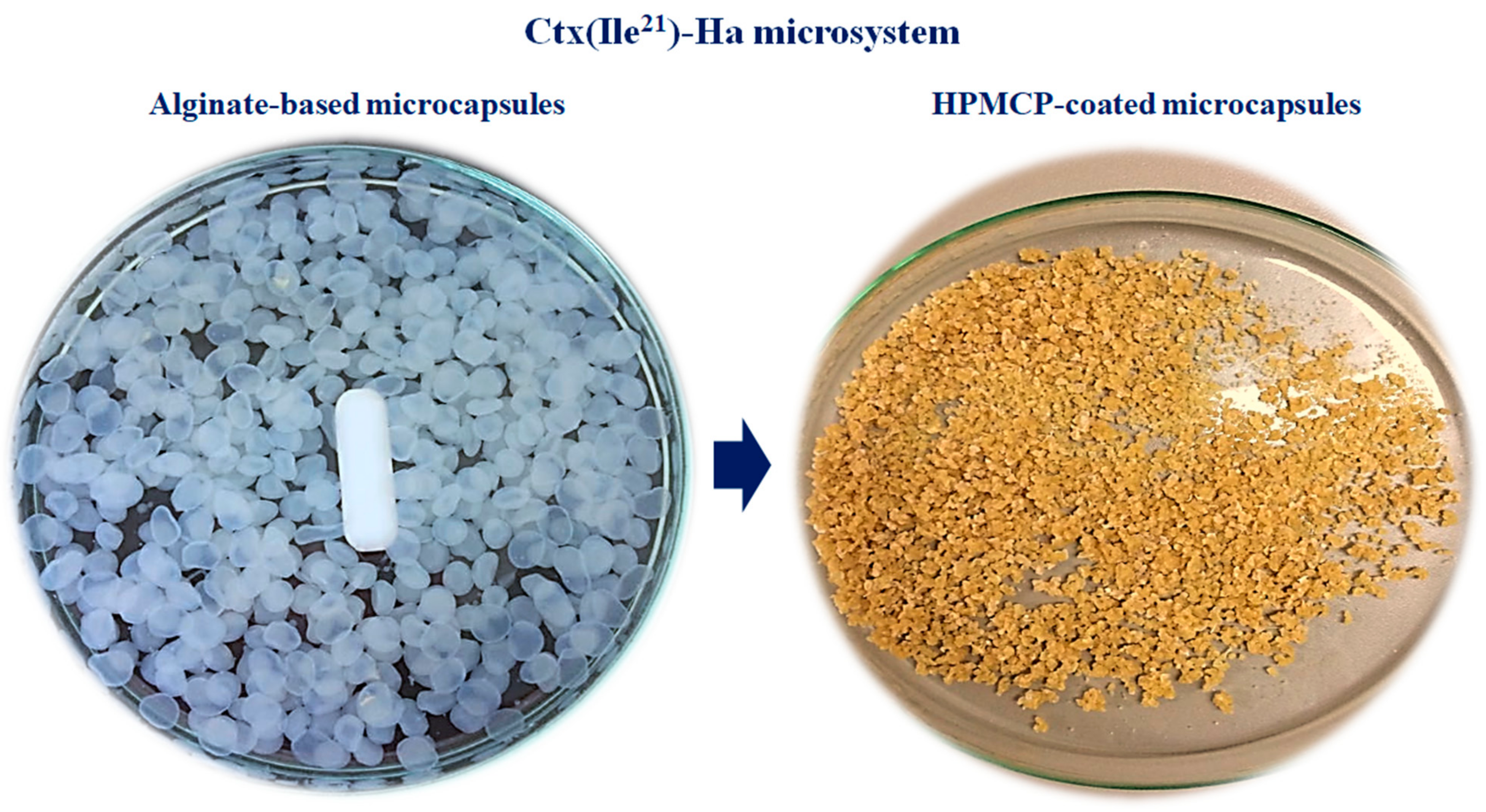
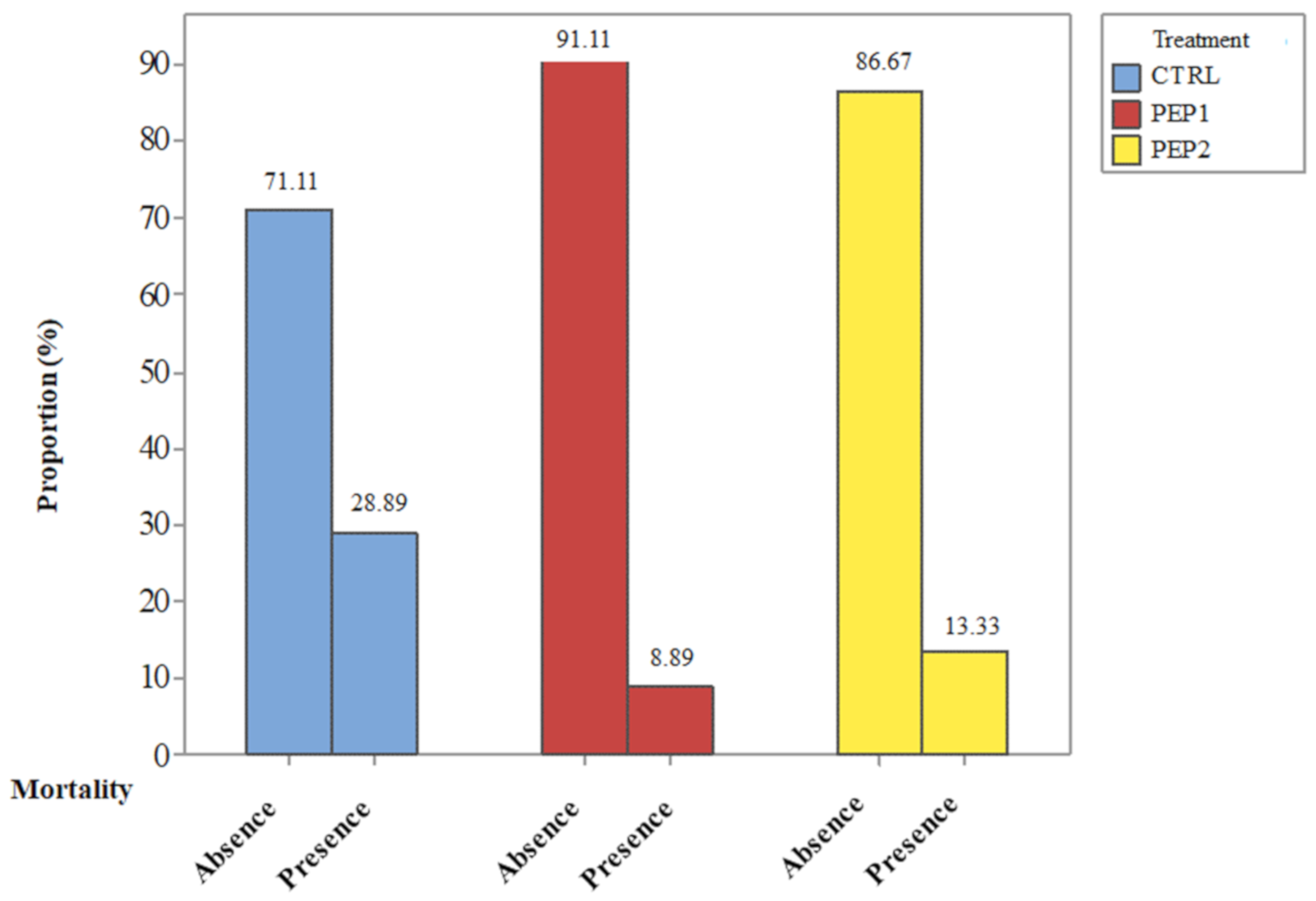
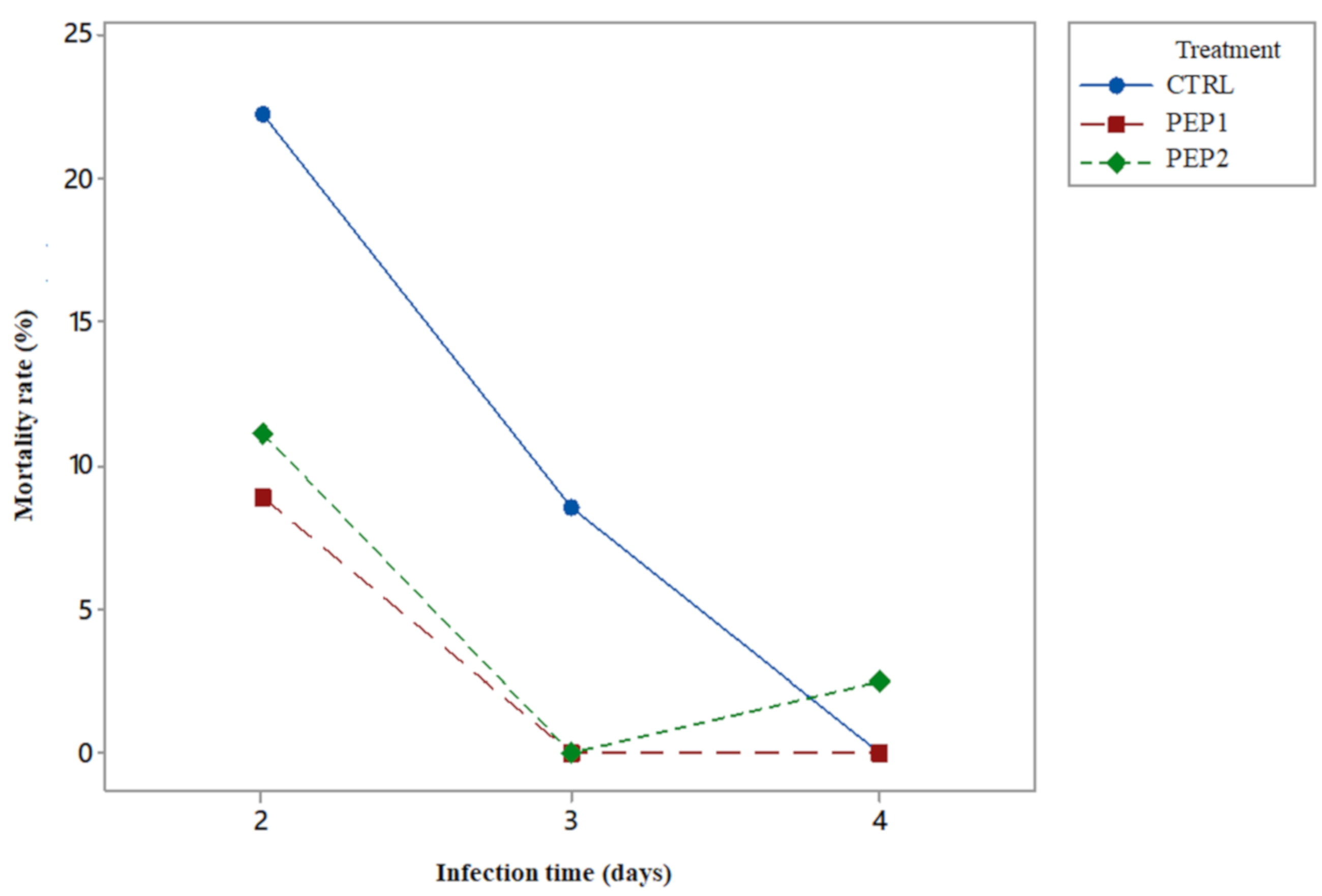

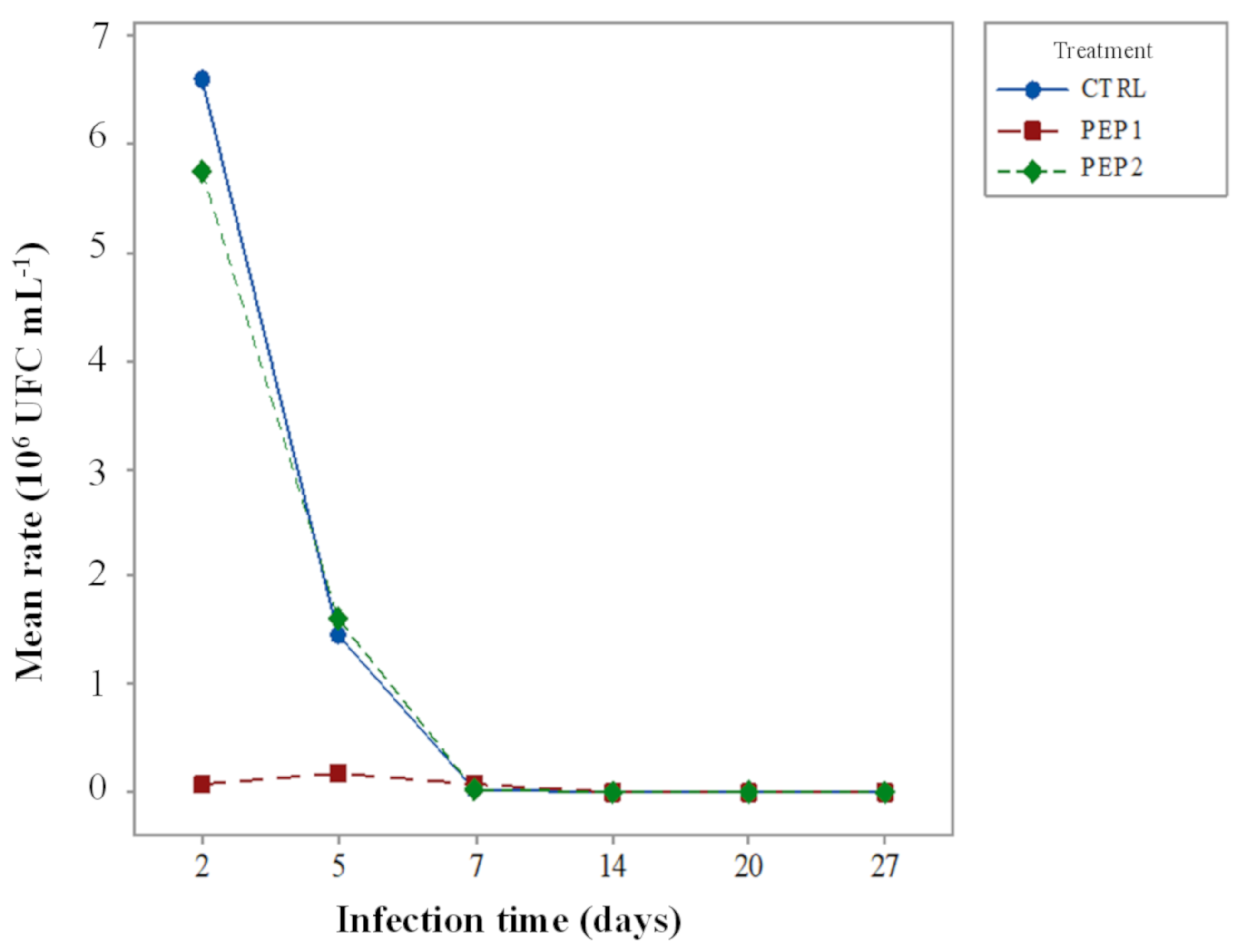

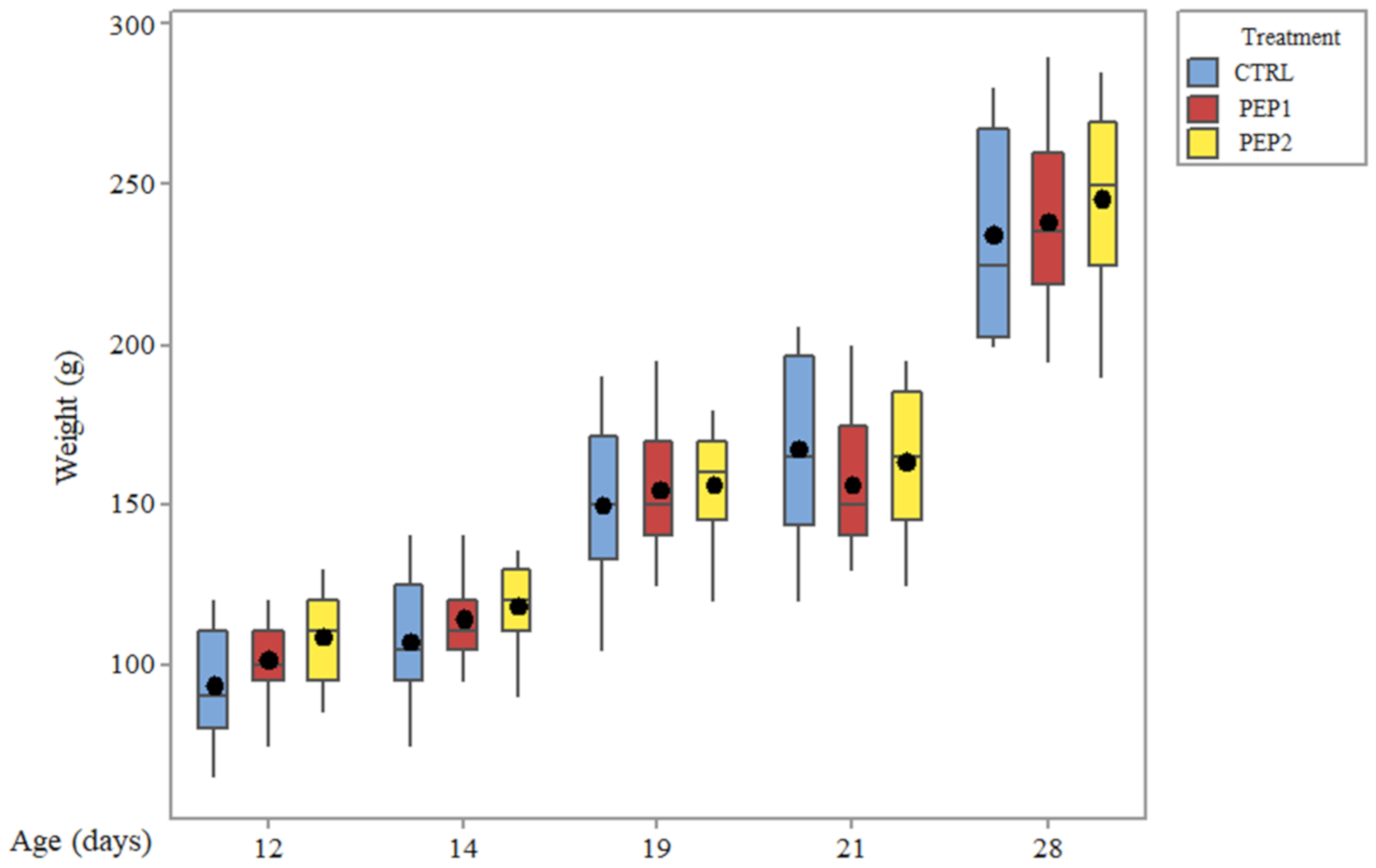
Publisher’s Note: MDPI stays neutral with regard to jurisdictional claims in published maps and institutional affiliations. |
© 2021 by the authors. Licensee MDPI, Basel, Switzerland. This article is an open access article distributed under the terms and conditions of the Creative Commons Attribution (CC BY) license (https://creativecommons.org/licenses/by/4.0/).
Share and Cite
Roque-Borda, C.A.; Pereira, L.P.; Guastalli, E.A.L.; Soares, N.M.; Mac-Lean, P.A.B.; Salgado, D.D.; Meneguin, A.B.; Chorilli, M.; Vicente, E.F. HPMCP-Coated Microcapsules Containing the Ctx(Ile21)-Ha Antimicrobial Peptide Reduce the Mortality Rate Caused by Resistant Salmonella Enteritidis in Laying Hens. Antibiotics 2021, 10, 616. https://doi.org/10.3390/antibiotics10060616
Roque-Borda CA, Pereira LP, Guastalli EAL, Soares NM, Mac-Lean PAB, Salgado DD, Meneguin AB, Chorilli M, Vicente EF. HPMCP-Coated Microcapsules Containing the Ctx(Ile21)-Ha Antimicrobial Peptide Reduce the Mortality Rate Caused by Resistant Salmonella Enteritidis in Laying Hens. Antibiotics. 2021; 10(6):616. https://doi.org/10.3390/antibiotics10060616
Chicago/Turabian StyleRoque-Borda, Cesar Augusto, Larissa Pires Pereira, Elisabete Aparecida Lopes Guastalli, Nilce Maria Soares, Priscilla Ayleen Bustos Mac-Lean, Douglas D’Alessandro Salgado, Andréia Bagliotti Meneguin, Marlus Chorilli, and Eduardo Festozo Vicente. 2021. "HPMCP-Coated Microcapsules Containing the Ctx(Ile21)-Ha Antimicrobial Peptide Reduce the Mortality Rate Caused by Resistant Salmonella Enteritidis in Laying Hens" Antibiotics 10, no. 6: 616. https://doi.org/10.3390/antibiotics10060616
APA StyleRoque-Borda, C. A., Pereira, L. P., Guastalli, E. A. L., Soares, N. M., Mac-Lean, P. A. B., Salgado, D. D., Meneguin, A. B., Chorilli, M., & Vicente, E. F. (2021). HPMCP-Coated Microcapsules Containing the Ctx(Ile21)-Ha Antimicrobial Peptide Reduce the Mortality Rate Caused by Resistant Salmonella Enteritidis in Laying Hens. Antibiotics, 10(6), 616. https://doi.org/10.3390/antibiotics10060616









